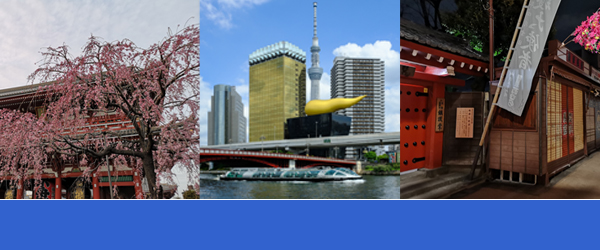What is your favorite Japanese sweet?
Matcha, Anko, Mochi…These are common answers.
And luckily, there is a cafe where you can enjoy them.
That cafe is “梅園(Ume-zono)”.🌸
With the aroma of sweets, you will explore 桃源郷 Togenkyo (different region ).🗾
It was founded in 1854 when a teahouse was opened in a corner of Umezonoin, a branch of Sensoji Temple.🏮
Umezonoin has a lot of Japanese plum trees, its name is “Ume” in Japanese. Therefore the shop’s name “Umezono” is related to this.🌸
The first generation gained popularity for the original awa-zenzai, which became a Tokyo specialty, and since then we have continued the tradition as a sweet shop for more than 170 years.😊
That popularity can be seen in Japanese literature.
One of the Japanese modern writers, Nagai Kafu wrote about how prosperous it was at that time in his famous novel “踊り子 Odoriko”.
Like this, Ume-zono sweets are loved for a long time.😊
Umezono offers a lot of mochi sweets.
Do you know mochi?
Mochi is a traditional Japanese food made from glutinous rice, also called “rice cake.” 🌾This rice is steamed and pounded into a sticky, elastic dough. Mochi is known for its chewy texture and is often eaten during special occasions like the New Year.🌅
There are several types of mochi, and I’ll introduce a few of the most common ones:
======================================
- Kagami Mochi (鏡餅): This type of mochi is used as a New Year’s decoration and is an offering to the gods. It’s typically two round mochi stacked on top of each other, with a daidai (a type of orange) placed on top.🍊
- An Mochi (あんもち): This is mochi filled with sweet red bean paste called “anko.” The paste is made from azuki beans, and it’s not overly sweet, which pairs nicely with the chewy mochi.
- Kinako Mochi (きなこもち): Mochi that is coated with kinako (roasted soybean flour) and sometimes sprinkled with sugar. It has a sweet and nutty flavor, and the kinako adds a nice roasted taste.
- Mitarashi Dango (みたらしだんご): Skewered rice dumplings (similar to small mochi) that are grilled and coated with a sweet soy sauce glaze. They’re often eaten as a snack or dessert.🍡
- Mochitsuki (餅つき): The process of making mochi by pounding steamed rice in a large mortar called an “usu” with a wooden mallet called a “kine.” This is often done during the New Year and is a fun, community event where people gather to make fresh mochi.
======================================
Mochi is used in many traditional Japanese dishes, such as ozoni (a New Year’s soup with mochi), and oshiruko (a sweet red bean soup with mochi). It’s a versatile ingredient that can be eaten as is or combined with various sweet and savory toppings.🍡
The chewy, sticky texture of mochi is a big part of its appeal, and it’s a beloved food in Japanese culture!😊
1 Awa-zenzai

Taste ☆☆☆
Cultural ☆☆☆☆☆
Cute ☆☆
Awa-zenzai is the most historical menu in Ume-zono. It has lasted for more than 170 years.😲
Awa-zenzai is made of Awa-mochi and anko ( sweet red bean’s paste).
Normally, mochi is made of rice, and it has a smooth texture. However, awa-zenzai is made of Awa, it has a rough texture. Therefore, FOR ME it is really odd to eat.😲
If you imagine that 170 years ago, there were the people who ate it, and still you eat it, are you getting excited?
2 Kuromitsu-Kinako pafe

Taste ☆☆☆☆☆
Cultural ☆
Cute ☆☆☆☆☆
Kuromitsu-Kinako parfait is so cute and yummy that I cannot eat, but eat .🤤
Kuromitsu (黒蜜) is a thick, dark syrup made from unrefined kurozatō (黒砂糖, Okinawan black sugar). It has a deep, molasses-like flavor with a rich caramelized sweetness. Think of it as the Japanese version of maple syrup or honey, but with a more complex, slightly smoky taste.
Kinako (きな粉) is roasted soybean flour.It has a nutty, slightly sweet flavor and is commonly used in Japanese desserts. It started to spread from the Edo period (1603~1868).
I want to say, Kuromitsu-Kinako is the golden combination, and when that combi becomes a parfait, it’s perfect.✨
Also, there are some Japanese sweets in parfait, warabi-mochi and dango(dumpling sweet), so if you eat this parfait, you can enjoy Japanese sweets’s travel.🌏
3 Matcha parfait (Green tea parfait)

Taste ☆☆☆☆☆
Cultural ☆☆☆
Cute ☆☆☆☆☆
There is another parfait,which is matcha parfait !🍵
Matcha in its current form was introduced by Eisai, a buddhist priest during the Kamakura period (1185~1333). Now, every Asakusa street has the matcha sweet, but this matcha parfait is the best of all matcha sweets.🤤
What is so special? That is the harmony of matcha and Japanese traditional sweets.
Matcha parfait also includes the warabi-mochi and dango(dumpling sweet), so if you are greedy, you can still enjoy Japanese sweets in one sitting.🍡
4 Matcha set (Green tea set)

Taste ☆☆☆☆☆
Cultural ☆☆☆☆☆
Cute ☆☆☆☆
Matcha set is the set of authentic matcha and Japanese traditional sweets that you can choose.🍵 If you want to try “real” “authentic” matcha, or want a Japan-only experience, this is the best ”match” for you.😊
Authentic matcha has bitterness, but also mellowness.
And with this matcha, you can enjoy Japanese sweets. You can choose from some kinds of traditional Japanese sweets like kintsuba, mochi, and seasonal sweets.🌸
Collaboration of green tea and sweets brings you the smell of history.
5 Shiratama-cream-Anmitsu

Taste ☆☆☆☆
Cultural ☆☆☆☆
Cute ☆☆☆☆
Shiratama Cream Anmitsu is a Japanese dessert that combines several traditional ingredients in a delicious, sweet dish. Here’s a breakdown of its components🍒:
- Shiratama – These are small, chewy rice dumplings made from glutinous rice flour (similar to mochi). They are soft and often round in shape, similar to traditional mochi balls, but typically made with less sugar and a slightly firmer texture.🍡
- Cream – This part of the dish involves whipped cream or sometimes a rich, sweet custard-like cream, which adds a smooth and rich contrast to the chewy rice dumplings.
- Anmitsu – Anmitsu is a popular Japanese dessert that typically consists of agar jelly (a gelatinous substance made from seaweed), sweet red bean paste (anko), fresh fruits (like peaches or cherries), and syrup. It’s often served with a sweetened black syrup called mitsu.
When combined, Shiratama Cream Anmitsu features the chewy shiratama rice dumplings, often alongside other typical anmitsu components like the agar jelly, sweet red bean paste, fruits, and a drizzle of syrup, all topped with cream for a rich, indulgent treat.🤤
It’s a refreshing and somewhat customizable dessert that’s loved for its mix of textures and flavors—sweet, chewy, creamy, and slightly tangy from the fruits or syrup.🍒
Especially this ume-zono Shiratama-Cream-Anmitsu is good in Anko.🥄
The red bean paste here is not too sweet, dense, and delicious. When it is mixed with vanilla ice cream, it becomes mellow and even more enjoyable.
The texture of the agar in the anmitsu is also good.
This shiratama cream anmitsu is a paradise of flavors and textures.🍡🌸
Ume-zono brings you the journey of Japanese traditional sweets culture.
Why not take this opportunity to come to Japan and be dazzled by the sweet aroma?😊








